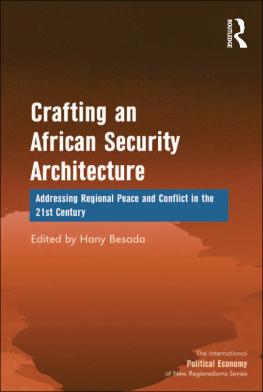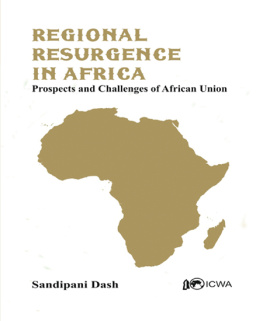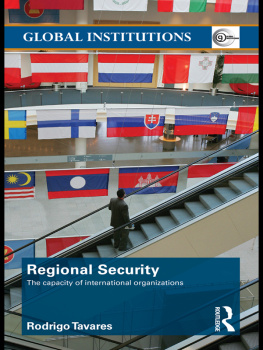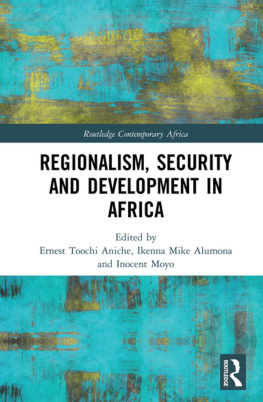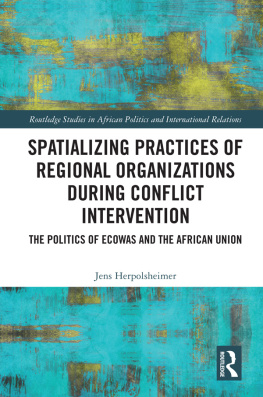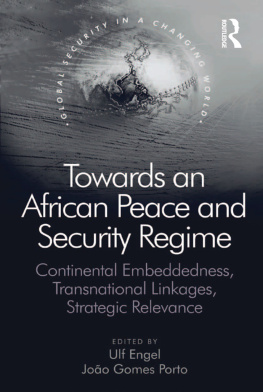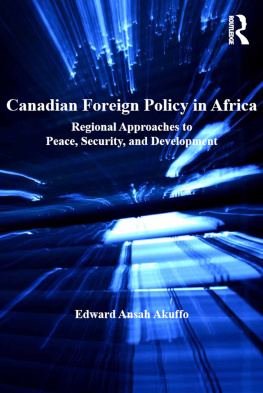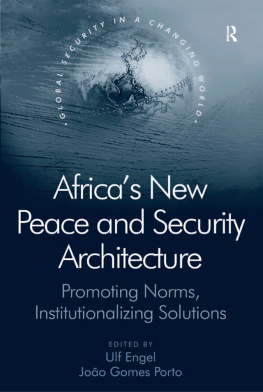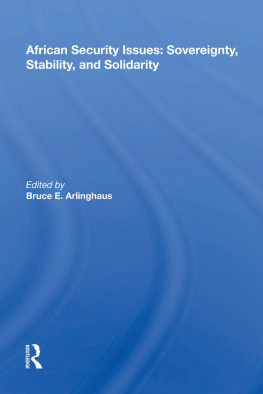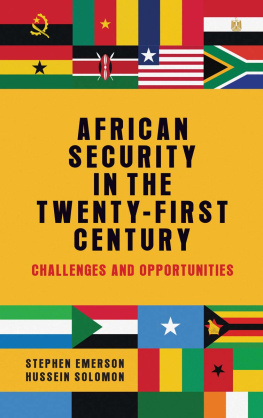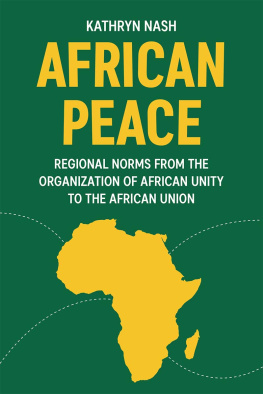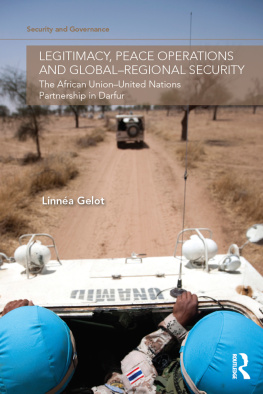
Regional Organizations in African Security
The African continent is plagued by some of the most brutal and violent conflicts in the world. At the same time that warfare is changing, so has the states capacity to provide security and political stability to its citizens. This book deals with the role of regional organizations in Africas security. It focuses on three basicyet often overlookedquestions: (1) the advantages and disadvantages of African regional and sub-regional organizations vis--vis other security mechanisms, (2) the official and unofficial reasons to intervene, and (3) whether security is actually protected by the peace activities carried out by the regional organizations.
The contributors to the bookall leading researchers in the fieldsystematically assess and compare the role of the African Union (AU), the Economic Community of West African States (ECOWAS), the Intergovernmental Authority on Development (IGAD), the Economic Community of Central African States (ECCAS), and the Southern African Development Community (SADC).
This book was based on a special issue of African Security.
Fredrik Sderbaum is Associate Professor in the School of Global Studies at the University of Gothenburg, Sweden, and Senior Associate Research Fellow at the United Nations University-Comparative Regional Integration Studies (UNU-CRIS), Belgium.
Rodrigo Tavares is Associate Research Fellow at the United Nations University-Comparative Regional Integration Studies (UNU-CRIS), Belgium.
Regional Organizations in African Security
Edited by
Fredrik Sderbaum and Rodrigo Tavares
First published 2011
by Routledge
2 Park Square, Milton Park, Abingdon, Oxon, OX14 4RN
Simultaneously published in the USA and Canada
by Routledge
711 Third Avenue, New York, NY 10017
Routledge is an imprint of the Taylor & Francis Group, an informa business
2011 Taylor & Francis
This book is a reproduction of African Security, vol.2, issue 2-3. The Publisher requests to those authors who may be citing this book to state, also, the bibliographical details of the special issue on which the book was based.
Typeset in Times by Taylor & Francis Books
All rights reserved. No part of this book may be reprinted or reproduced or utilised in any form or by any electronic, mechanical, or other means, now known or hereafter invented, including photocopying and recording, or in any information storage or retrieval system, without permission in writing from the publishers.
British Library Cataloguing in Publication Data
A catalogue record for this book is available from the British Library
ISBN13: 978-0-415-85028-5 (pbk)
ISBN13: 978-0-415-59787-6 (hbk)
Disclaimer
The publisher would like to make readers aware that the chapters in this book are referred to as articles as they had been in the special issue. The publisher accepts responsibility for any inconsistencies that may have arisen in the course of preparing this volume for print
First issued in paperback 2013
Contents
Fredrik Sderbaum and Rodrigo Tavares
Ulf Engel and Joo Gomes Porto
Paul D. Williams
Cyril I. Obi
Tim Murithi
Angela Meyer
Maxi Schoeman and Marie Muller
Joo Gomes Cravinho
James J. Hentz, Fredrik Sderbaum, and Rodrigo Tavares
Fredrik Sderbaum and Rodrigo Tavares
School of Global Studies, University of Gothenburg, Gothenburg, Sweden and United Nations University Comparative Regional Integration Studies, Bruges, Belgium
ABSTRACT. The African continent is plagued by some of the most brutal and violent conflicts in the world. At the same time that warfare is changing, so has the states capacity to provide security and political stability to its citizens. In this context, what is the role of new conflict management actors, in particular regional organizations? This article starts out by situating conflicts and peace operations on the African continent. It then moves on to problematize the role of regional organizations in African security with emphasis on three key topics: (1) the advantages and disadvantages of African regional and subregional organizations vis--vis other security mechanisms, in particular UN peace operations; (2) the official and unofficial reasons to intervene; and (3) whether security is actually protected by the peace activities carried out by the regional organizations.
INTRODUCTION
Some of the most challenging conflicts in the world over the past two decades are found in Africa (e.g., Burundi, Chad, Darfur, Democratic Republic of the Congo, Liberia, Rwanda, Sierra Leone, Somalia, Uganda). Despite the varied and complex nature of armed violence on the continent, most share a number of characteristics, which in the literature are sometimes referred to as new wars in contradistinction to old wars.1
A characteristic of these wars is the new prominence demanded by, and given to, subnational actors and groups like rebel movements and mercenaries who often try to function as though they were recognized members of the international community. The actions of these actors and the nature of these crises have undermined perceptions of the state in Africa as the dominant and significant actor in the international system. These groups have succeeded in introducing new practices into the conduct of armed conflicts, effectively contesting some archetypal conceptions of modern warfare (one reason why some scholars prefer the new wars label). Subsequently, the dynamics of these conflicts have also influenced, and indeed transformed, the patterns of subregional and external involvement in, and responses to, such crises. This has at least two important implications.
First, in many of these wars and conflicts, the distinction between combatants and civilians is unclear, as is that between who is good and evil, friend and foe, because loyalties are quickly changing. Second, even if most contemporary conflicts in Africa are often defined as domestic, they are deeply embedded in a regional and cross-border context. As illustrated by the cases in Liberia, Sierra Leone, the DRC, and more recently Sudan/Chad, most conflicts on the African continent spill over into neighboring countries or draw regional actors into what is often better understood as regional war zones. Although the Uppsala Conflict Database shows that the number of armed conflicts in Africa is decreasing (from 18 conflicts in 1999, to 12 in 2008),2 the striking feature of African warfare is the regionalization of conflict.3
When the international community does intervene to mitigate armed strugglesmost often in the form of a United Nations peacekeeping missionthe results have been mixed. Most of the difficulties are connected to the heterogeneity and complexity of conflict in Africa. During the Cold War, most conflicts in Africa followed the systemic logic of that order. They formed part of the bipolar struggle or were solved by way of interventions from superpowers, former colonial powers, or powerful neighbors. However, in the postCold War era a new pattern has emerged whereby conflicts are allowed to erupt (often erratically) and also continue, waiting for more appropriate solutions. In this regard, some peace operations have succeeded, while many others have failed to quell violence or restore order in the countries to which they were deployed. Presently, the UN leads (or co-leads) eight peace operations in Africa (Burundi, Cte dIvoire, the Democratic Republic of the Congo, Liberia, Western Sahara, Central African Republic/Chad, Darfur, and Sudan). In total, there have been twenty-six UN peacekeeping missions in Africa since 1948.


